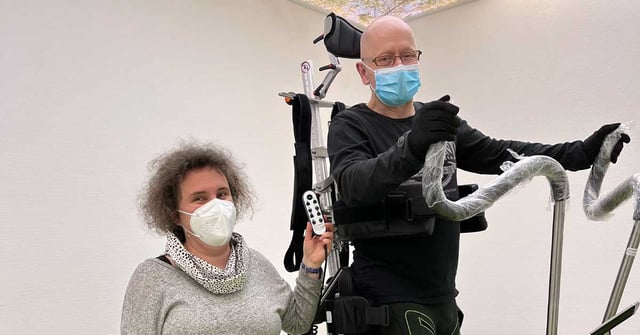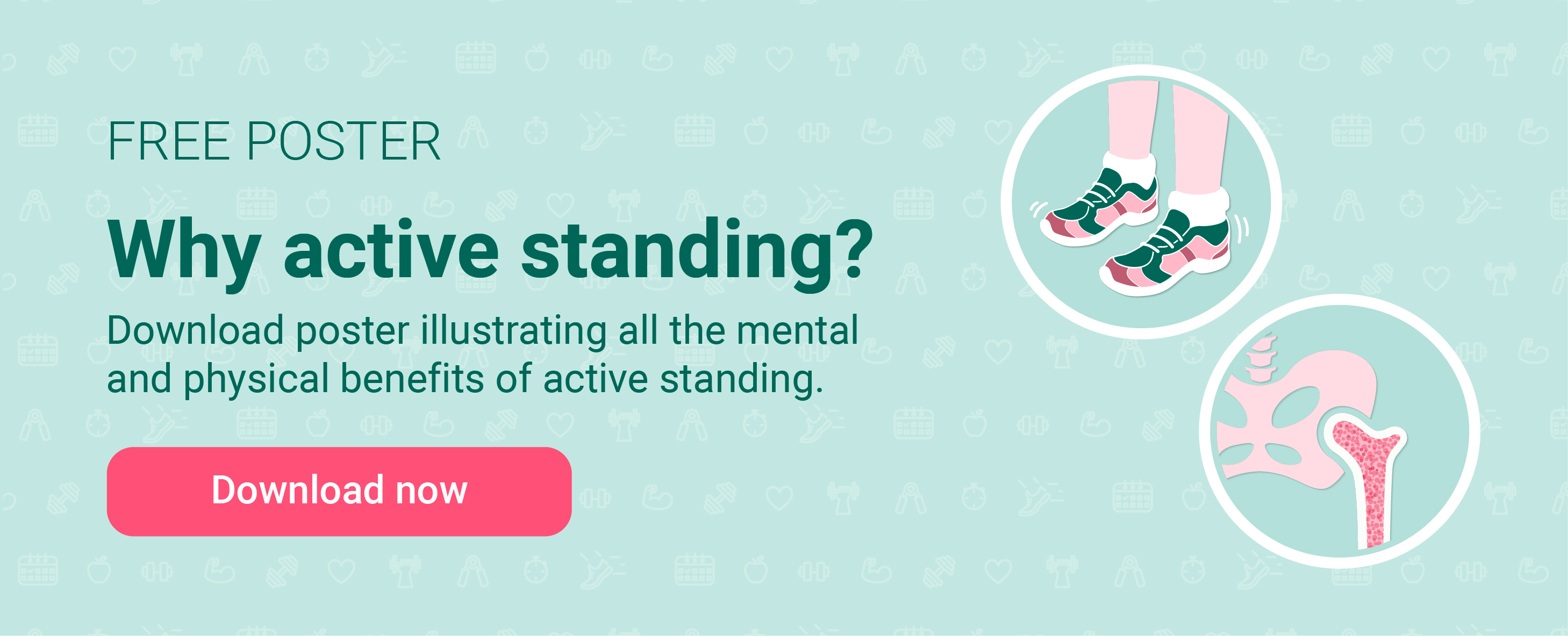
Feb 28, 2022Is the Innowalk Pro a profitable investment?

Back to Blog Overview
Anke Trinkner has had her own occupational therapy practice in Besigheim, Germany, for 22 years. Together with five other members of staff, she treats and supports patients in maintaining and improving their ability to cope with the physical demands of daily life.
Their therapy aims to improve movement coordination of the whole body, stabilize balance, improve muscle tone regulation or improve motor and cognitive skills such as alertness, attention span, concentration, endurance, the ability to plan and execute actions, among others.

In mid-2019, Ms. Trinkner decided to purchase an Innowalk Pro, a motor-assisted whole-body trainer, and has now been using it in her practice since September 2019.
She first encountered the medical device at the Leipzig Trade Fair and Congress for medical rehabilitation at the beginning of 2016. At a symposium held in Ludwigshafen by German trade and professional associations shortly after, her attention was again drawn to the Innowalk Pro.
On that occasion, a patient with severe disabilities was training in the Innowalk Pro. This showed her that the device can also be used by people with the most complex motor impairments.
Why did Ms. Trinkner opt for the Innowalk Pro, a dynamic stander?
In Ms. Trinkner’s occupational therapy practice, several seriously injured athletes (including one with complete paraplegia), who wanted to return to an active life, requested it. They wanted to be able to walk again. Athletes have their own kind of ambition; they want to train intensively and make quick progress. Up until then, this option was not available within the practice. - In the day-to-day running of the clinic, the first thing all the patients in question specify as their objective is to be able to stand and walk; this is their main goal, Ms. Trinkner explains.
The process for deciding on the Innowalk Pro
As more and more patients became interested in this type of motor-assisted therapy and enquiries increased, Ms. Trinkner decided to take her practice in this new direction. This decision was further reinforced by the fact that, in her view, previous therapies for these patients had neither been satisfactory nor brought any underlying improvement.
Nevertheless, in the process of deciding on a motor-assisted device for use as an item of therapeutic equipment, she deliberately took her time and tried out various machines. Ms. Trinkner borrowed these from the manufacturers for two to six months and tested them intensively, always with the same patients. She was looking for an assistive device that was compact, would challenge her patients, and looked promising in terms of goal achievement. Additionally, it should address patients’ intrinsic motivation and increase their ambition through enjoyment and success, so that they would be inspired to train.
For two and a half years, Ms. Trinkner had various devices in her occupational therapy practice. When manufacturers couldn’t provide equipment for testing, she would visit them with her patients to carry out testing and training on their premises. In this way, she was finally able to draw a full comparison of all relevant devices on the market.
- With a purchase of this scale, in both spatial and financial terms, I wanted to be sure that I was purchasing the best possible device for patient success and motivation, and one that my therapists could handle easily and quickly, Ms Trinkner explains.
Who is the Innowalk Pro intended for?
Patients with complete paraplegia, unresponsive wakefulness syndrome, hemiparesis, MS, Parkinson’s and tumour disease tested the various devices. In all cases, their ability to walk or stand was severely impaired or completely absent.
As a result, a direct comparison could be made in terms of handling and implementation, the degree of challenge the device presented to the patient, as well as how it might help achieve objectives. - I wanted to make sure that I was choosing a modern, future-oriented and durable device, which was easily adaptable and versatile and came complete with integrated artificial intelligence. By trying the device out with real patients, I received direct feedback and was able to assess the success of the device in direct comparison with each other, weighing up all the advantages and disadvantages, Ms. Trinkner says, describing the long decision-making process.
- What my patients particularly appreciate about the Innowalk Pro is that they can stand on their own two feet again, whereas in other devices they are just «hanging in a belt», Ms. Trinkner explains. During the test phase, the feedback from all five patients indicated that they felt like they were back on their feet. This clear thumbs-up resulted in a decision in favour of the Innowalk Pro.

We can barely meet the high demand for training hours
- I can honestly say that everyone benefits from this purchase. Firstly, I do as practice owner, because I can keep being an independent clinic vis-à-vis health insurance companies, doctors and patients. Secondly, it allows me to attract new staff, for whom it is a completely new, interesting and, above all, motivating field of therapy. With the Innowalk Pro, you can quickly achieve success with patients, even where doctors have officially declared them to have little chance of it. And thirdly, it also motivates the patients. They are back on their own two feet and are at eye level with you. This is such an encouraging perspective if the only alternative is to sit or lie down! Ms. Trinkner explains.
- In addition, we have a lot of new patient enquiries as a result of the Innowalk Pro, says Ms. Trinkner with considerable satisfaction. - Word has spread that we have this motor-assisted whole-body trainer. Many new enquiries are coming in, in particular from athletes and people who are networking on social media. We also have patients with traumatic brain injury, multiple sclerosis or Parkinson’s, often organized in self-help groups or associations. There too, attention is being drawn to the Innowalk Pro, Ms.Trinkner smiles.
With the increase in number of patients, we have been able to hire another therapist, and this has led to higher practice turnover and higher throughput.
How does the Innowalk Pro make it easier for therapists?
With the Innowalk Pro, a significantly higher number of step repetitions is possible compared to what could be achieved manually by an occupational therapist with a patient. Using conventional methods, patients get tired, and the therapist has to exert more and more of their own strength to compensate. This task is now taken on by the motor-assisted movement trainer.
During the first few hours of therapy, the occupational therapist measures the patient in a few easy steps, records the data and then adjusts the Innowalk Pro accordingly. The patient can then train, and the therapist corrects posture or adapts the weight bearing settings, adjusts the speed or encourages the patient to pedal faster. The full-body movement trainer makes it easier and quicker to achieve the therapy objective. That’s why the device motivates patients and therapists alike.
Occupational therapists enjoy working with the Innowalk Pro
It is uncanny how patient motivation increases after just a short time, and this also spills over onto the therapists. It means a lot to patients to be able to stand on their feet again, especially if it has been a long time since they were last able to experience standing or see their legs like this. The patient sees progress, he/she trains hard and often, and at the same time it relieves the burden on the therapist.
What are the benefits of this full-body movement trainer?
Ms. Trinkner emphasises how easy it is to use. It only takes a single member of staff a short time to adjust the device to patients with different impairments, and all accessories can be attached or removed by one person. Other devices that she tested often required two members of staff. So, the short transfer and set-up time of five minutes maximum is yet another advantage.
The device is flexible in use and is fully compatible with additional tasks, as well as for motor and cognitive exercises. The detection system for muscular spasms, with its flexible and sensitive adjustment settings, helps therapists protect patients from injuries or complications.
With its compact and stable design, the Innowalk Pro takes up very little space and is also easy to transport, allowing it to be effortlessly moved to another room if required.
The occupational therapy practice is more attractive for new staff
On the one hand, it is exciting for any therapist to implement a therapeutic method using a technical aid. It provides a considerable increase in training routine efficacy. On the other hand, the Innowalk Pro significantly relieves the physical strain on staff.
How do you let people know about the Innowalk Pro?
- We don’t have to advertise at all, says Ms. Trinkner enthusiastically, - Word gets around so quickly through doctors, disability associations and the self-help groups. At the moment, we have more demand than we can meet with one device.
Which therapies are carried out with the Innowalk Pro?
The Innowalk Pro is used as part of standing and walking training, coordination and muscle tone regulation, balance training and also for muscular stabilization. It is also used to promote mobility, to prevent falls and to train a given physiological movement sequence when walking. Full-body movement training can be used to treat many neurological and orthopaedic diseases.
Can training in the Innowalk Pro be prescribed?
Training in the Innowalk Pro is either available on prescription or patients pay for the therapy themselves.
Patients look forward to training in the Innowalk Pro
At first, patients are sometimes sceptical. Many have not stood upright for years and are now meant to rely on technology. However, by the time they are onto their second therapy session, starting to know the ins and outs of the device, they are confident and look forward to the training. The fact that the patients are willing to train longer is also rated very highly by Ms. Trinkner. They often volunteer to keep going. Daniel Zabielski, a patient of her, also confirms this: - I really enjoy training in the Innowalk Pro. I have the feeling that both legs are active again and can really get engaged. I truly like coming to the therapy class, he says.
- Patients are more likely to be exhausted or sometimes annoyed when it comes to strenuous exercises. Sometimes they’re sad, disappointed and frustrated by their own lack of achievement, but that’s not the case with the Innowalk Pro, says Ms. Trinkner, who is extremely pleased with the device’s success. - You can see that the patients are happy, and they express their happiness – which is really rewarding.
The new EMA device by EzyGain and Kforce Plates
- I was also introduced to these innovative devices for gait- and balance therapy. I find them very interesting and exciting, and a good supplement to what I do with my neurological patients. I can use them to treat more patients. Both EMA and the Kforce Plates help patients developing drive. With a motivating software App providing games and analysis of progress, even the most depressed people can set goals they are able to achieve. The high fun factor all these devices bring, creates motivation. Because if something is fun, you want to do it,” laughs Ms. Trinkner, as she concludes the interview.

Jens Kleine is a physiotherapist with many years of sales experience within assistive device technology across several European countries. He is very focused on users’ needs and dedicated in finding innovative solutions. Today, Jens has a product manager role working closely with both external clinicians, the salesforce and our R&D team. Always searching for solutions that bring movement to the people that need it most.


